Final report for OS16-098
Project Information
Our project addresses the issue of poor or lacking habitat for beneficial insects in agriculture. Through intentional management of strawberry field edges, we hope to show that pollinators and natural enemies can be conserved to provide improved pest control and crop pollination. As a result, the need for curative insecticides will be reduced, meaning unsustainable outcomes associated with overreliance on insecticides should be mitigated and costs associated with insecticide application reduced. As well, production of higher quality fruit will improve yields and income.
Flowering plants will provide the necessary habitat to improve beneficial insect communities in Florida strawberry fields. Early establishment of predatory Orius will prevent thrips outbreaks crop and improve yield. Increased abundance and diversity of pollinators will aid improving fruit set and quality. In achieving this, input costs associated with insecticides for control will be reduced and revenue generated by greater harvest will be increased. Therefore, our work will contribute to making the whole of strawberry production in Florida more productive, sustainable, and beneficial to the environment, public health and human communities.
Cooperators
- (Researcher)
- (Educator and Researcher)
- (Researcher)
Research
- Two species of flowering plants (Spanish needles, Bidens alba and Sweet alyssum, Lobularia maritima) were grown from seed in the greenhouse and then transplanted to the outer strawberry row (instead of strawberry plants) of the raised, plastic bed on the edge of a field shortly after strawberries were transplanted. For the 2016-2017 growing season, one row of alyssum was replaced a row of strawberry in the raised bed and the row of Spanish needles was in the bed shoulder (see attached photo). For the 2017-2018 season, alyssum was grown in both rows of the outside bed and Spanish needles were adjacent to the bed.
- Logic: These two species of plants produce many flowers during the winter growing period of Florida strawberries and in preliminary studies had a high ratio of thrips predators to thrips.
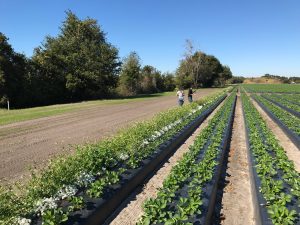
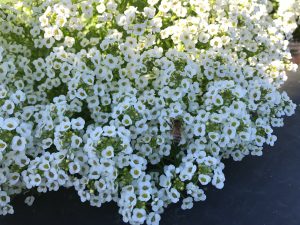
- Logic: These two species of plants produce many flowers during the winter growing period of Florida strawberries and in preliminary studies had a high ratio of thrips predators to thrips.
- The numbers of thrips in strawberry flowers and on strawberry leaves (leaves in 2016-2017 only) and numbers of thrips predators (mainly Orius, a minute pirate bug) were evaluated in plots with and without adjacent flowering plants.
- Logic: Flowering plants would contribute limiting resources to thrips predators, increasing their numbers and decreasing thrips numbers.
- The abundance and diversity of known and potential pollinators were evaluated using bowl traps and visual counts on strawberry flowers in plots with and without adjacent flowering plants.
- Logic: Flowering plants would attract pollinators who would then move to adjacent strawberry flowers.
- The numbers of damaged strawberries due to thrips feeding and size and quantity of marketable strawberries were assessed in 2016-2017 only.
- Logic: Fewer thrips and improved pollination would lead to higher marketable yields.
- In 2016-2017, Spanish needle flowering peaked in early December, around the time of first strawberry flowering, at 75 flowers per 0.25 m2. By the peak of second strawberry flowering, there were 40-50 Spanish needle flowers per 0.25 m2. Sweet alyssum was measured by plant volume (diameter x height measurement), reaching maximum sizes of 20,000 - 25,000 cm3 during both periods of peak strawberry flowering. For 2017-2018, calculations of flower numbers and diameters were comparable to the previous year, however, by the last count date, Feb. 22, sweet alyssum flowers had senesced and plants were dying.
- In 2016-2017, flower thrips incidence in strawberry flowers was much higher in strawberry row 1 near flowering plants than near no flowering plants on Nov 21. However, flower thrips numbers declined more rapidly in Dec. in strawberry flowers next to flowering plants than next to no flowering plants. This was likely due to the greater abundance in Dec. of the predatory bug, Orius, in strawberries next to flowering plants than next to no flowering plants. There were less striking differences in strawberry row 6, although there tended to be more thrips early in the season near flowering plants than near no flowering plants, but more thrips near no flowering plants than near flowering plants. In 2017-2018, we focused mainly on the later season populations of thrips and found similar numbers in strawberry row 1 whether there were flowering plants or not, but in strawberry row 6, there was a pronounced peak of thrips in strawberry flowers where there were no flowering plants compared to lower numbers where there were flowering plants. Orius numbers were not highly different between plots with or without flowering plants.
- In 2016-2017, chilli thrips incidence on strawberry leaves was reduced by 50% early in the season on plants next to flowering plants. Few chilli thrips were found later in the season (Nov-Feb). Leaf damage due to chilli thrips was also reduced by 50% early in the season on plants next to flowering plants. Chilli thrips were not assessed in 2017-2018.
- In 2016-2017, strawberry flower insect visitation rate (averaged over the entire growing season) was 16% higher on plants bordering flowering plants, but it was more than double on plants 6 rows from flowering plants than on plants 6 rows from field edges without flowering plants. Visitation rate results from 2017-2018 have not yet been calculated.
- About three times more strawberries were culled due to thrips damage from plants near no flowering plants compared to near flowering plants. However, about 8 times more strawberries were misshapen and culled from plants next to flowering plants compared to next to no flowering plants. There was no overall difference in yield (from 3 picks during peak harvest in Dec.) from strawberries next to flowering plants or not.
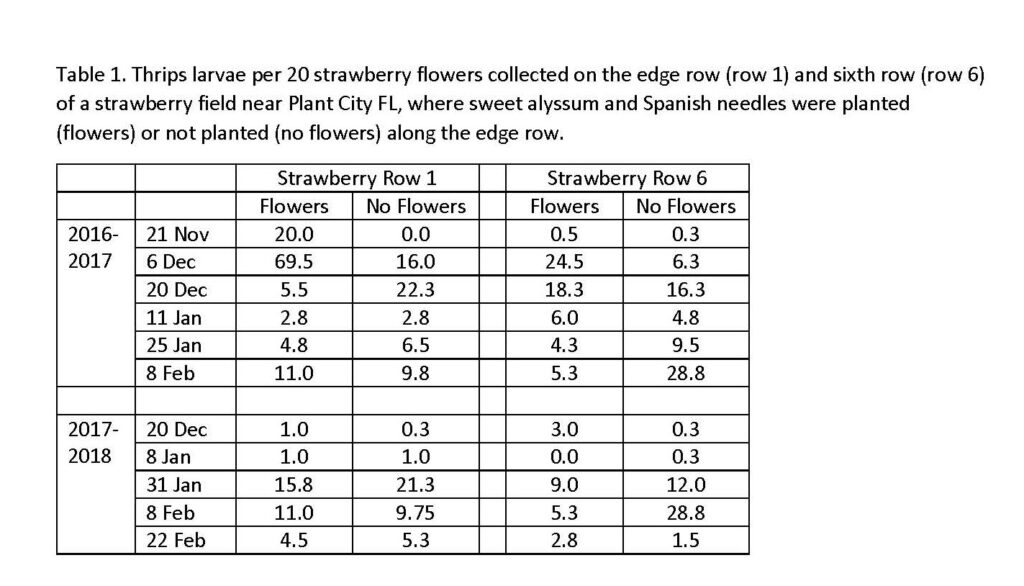
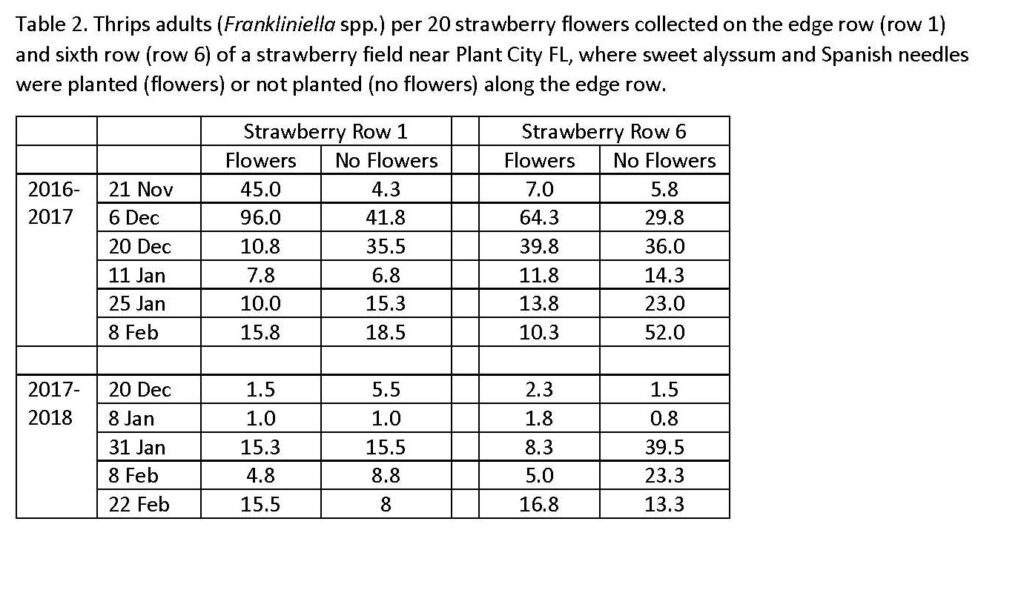
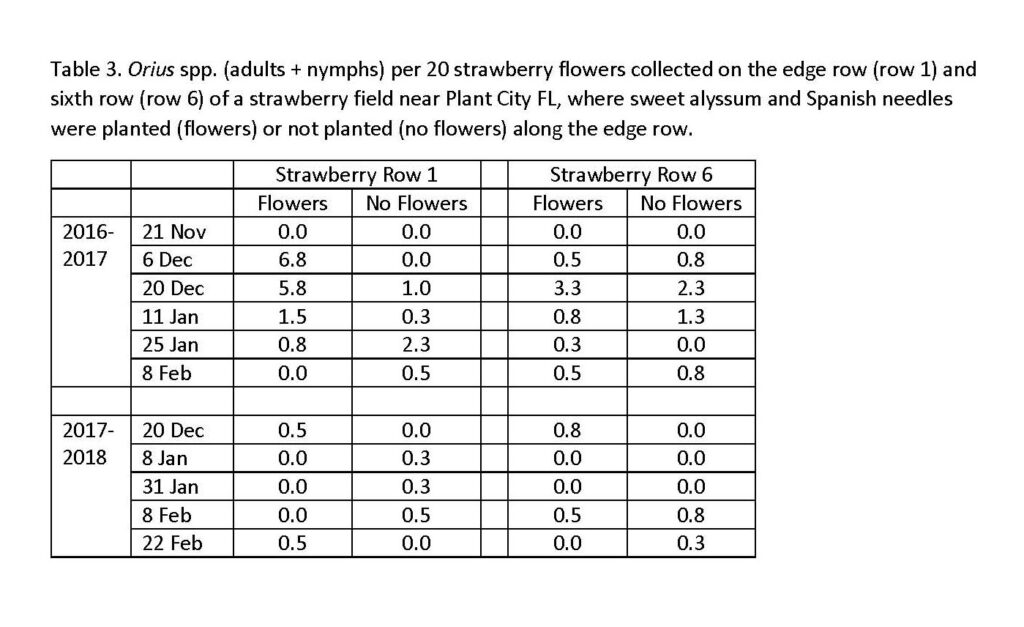
Educational & Outreach Activities
Participation Summary:
A presentation of the project results to-date was made to about 15 strawberry growers and 15 industry/academic participants on June 7, 2017 at Gulf Coast Research and Education Center, University of Florida, Balm FL. Background information on thrips as pests and biological control agents of thrips as well as on pollination of strawberry and pollinators in Florida was provided. Participants had the opportunity to ask questions and provide feedback on the project in order to refine our approach to the research in the upcoming strawberry season in Florida.
A news article on the presentations and organic/sustainable strawberry production in Florida in general will be published in "In the Field" magazine.
A blog entry about the project was created in November 2016, at http://jmrlab.wordpress.com
A presentation was given at the Southeastern Branch Meeting of the Entomological Society of America, March 2018 in Orlando, FL.
A poster was prepared for the "Our Farms, Our Future" conference of SARE in St. Louis. However, due to organizational failures, the poster was not entered into the program and there was no space to put it up.
The results of this project will form part of Iris Strzyzewski's PhD thesis. We plan to publish the results in a peer-reviewed journal in the next 1-2 years and disseminate results in a fact sheet or technical article for strawberry growers.
Learning Outcomes
Project Outcomes
Our project will contribute to future sustainability of strawberry production in Florida by providing specific details and methods on how to improve thrips management without relying solely on insecticides and how to create habitat for pollinators and natural enemies of thrips and other pests. Monocropped agroecosystems are typically species poor and not biodiverse. Improved biodiversity will provide important and sustainable environmental and economic benefits to growers, field workers, consumers and society in general.
Using flowering plants, specifically sweet alyssum and Spanish needles, provided some reduction of flower thrips in strawberry. However, results were not highly consistent between years and effects appear to be quite local, meaning large strawberry fields would require many flowering plant strips. Therefore, it is difficult to calculate the direct benefits to farmers. Our limited yield data showed little economic benefit, however, environmental benefits of flowering strips may be considerable, given the diversity of insects we observed on flowers, but did not fully quantify.
Future studies should be conducted to address flowering plant transplant timing. Earlier planting would allow beneficial insect communities to build before strawberries begin to flower. Adding flowering strips in the middle of fields should be evaluated for effects on bringing beneficials to field middles. We focused on the minute pirate bug, Orius, but other predators should be studied for their impacts on pests. Finally, we attempted to also study pollinators (and much of the data is still to be analyzed), but further emphasis should be put on studying pollinators in strawberry and methods to improve pollinator communities.